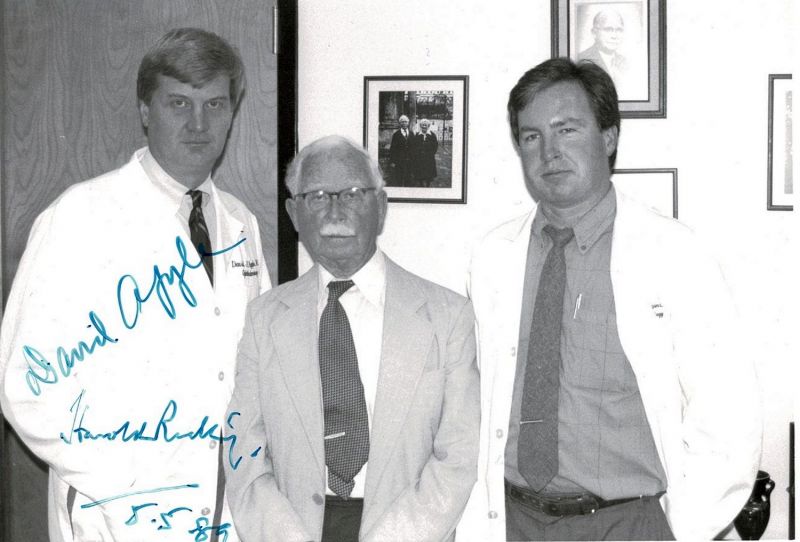
Jim Glanville
Eye surgery has undergone an incredible revolution during the lifetime of this columnist, who has twice been the beneficiary of that revolution.
In recent years, and with amazing and seemingly miraculous results, the Christiansburg ophthalmologist J. Stephen Hudgins has performed cataract surgery on each of the columnist’s eyes. The columnist today drives without glasses and requires only inexpensive dime-store lenses for reading.
Cataract surgery involves two main steps. First, the eye’s natural lens is surgically removed and second the removed lens is replaced by a synthetic lens made of plastic. The replacement is called an intraocular lens (IOL).
Age-related clouding of the eye’s natural lens is the principal reason that patients need cataract surgery, and that clouding is brought about over the years by exposure to the ultraviolet light of the sun. Recent studies partly funded the National Eye Institute confirm a link between the sun’s UV rays and a process called oxidative stress that occurs in the proteins in the fluid inside the eye.
An easily recognized analogy to the process of cataract formation comes when you cook an egg. When freshly broken into a frying pan the white of an egg is clear and transparent. After a little cooking, the clear fluid begins to whiten and becomes opaque in places. With further cooking the fluid becomes the completely white and totally non-transparent—as in a sunny side egg.
The chemical reactions in the protein of a cooking egg are similar to the chemical reactions in the protein of an aging eye.
Modern cataract surgery is a safe operation that can be performed even on the very elderly. For example the mother of the present Queen of England, Elizabeth Bowes-Lyon, who lived from 1900-2002, had double-eye cataract surgery at the age of 100!
The number of cataract operations is stunning. They are overwhelmingly the most common procedure performed by ophthalmic surgeons. According to estimates read by this columnist, possibly 4 million cataract procedures are performed annually in the US and another 25 million performed annually worldwide.
Despite these many cataract surgeries, the number of patients visually handicapped by cataracts around the world increases every year. It has been estimated that half of the approximately 40 million blind people in the world are blind because of cataracts.
After giving me a routine eye examination about 6-7 years ago, Dr. Hudgins mentioned that he had once met Sir Harold Ridley, the pioneer of intraocular lenses, and showed me a picture of himself taken with Ridley. That 1989 picture accompanies this article. From left to right in the picture are David J. Apple MD, Ridley, and Hudgins.
As I will describe in part 2 of this column, the introduction of intraocular lenses as a means of cataract treatment was fiercely fought by many members of the medical establishment. It took about three decades, from the date of Ridley’s first implantation of a plastic lens in 1949 until the early 1980s, before plastic lens implementation became the favored procedure for cataract surgery.
David J. Apple (1941-2011) met Ridley for the first time in Salisbury, England, in the summer of 1985. A few years earlier, in 1980, Apple had taken up a position at the ophthalmology department at the University of Utah. There, Apple turned his professional attention to the study and development of ever-better intraocular lenses. This work of Apple came to the attention of Ridley in England and led to Ridley’s “summoning” the American surgeon Apple to visit the retired Ridley at his home in rural England.
Following that initial meeting Apple met many more times with Ridley and became Ridley’s champion. Apple eventually published a biography of Ridley titled “Sir Harold Ridley and his fight for sight” (Slack Inc., 2006). This book is coincidentally an interesting autobiography of Apple himself.
In 1989 Apple accepted the chairmanship of the Storm Eye Institute at the Medical College of South Carolina in Charleston. The Storm family were wealthy, South Carolinian former plantation owners who became notable patrons of the Eye Institute.
One of the first things Apple did in Charleston was to arrange for his institution to award Ridley an honorary degree. This was done on April 29, 1989, when Ridley was made a Doctor of Humane Letters—the first honorary degree ever awarded to him by a medical school.
The accompanying photograph of Hudgins was taken a week after Ridley received that first honorary degree and is signed by both Apple and Ridley. At the time Hudgins was a resident (an MD in the final stage of training) at the Storm Eye Institute.
In part 2 I will tell the history of how treating Battle-of-Britain Hurricane fighter pilots during World War II led Ridley to conceive of intraocular implants and how Ridley went from being a “scorned outlaw to venerated prophet.”
Jim Glanville is a retired chemist living in Blacksburg. He has been publishing and lecturing for more than a decade about the history of Southwest Virginia.

